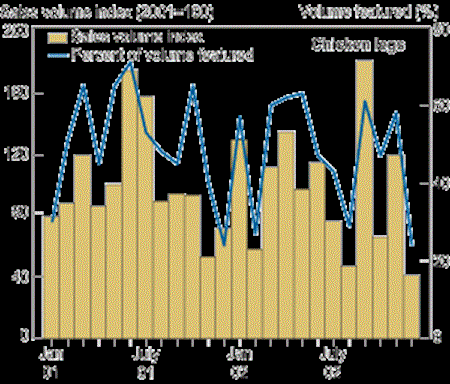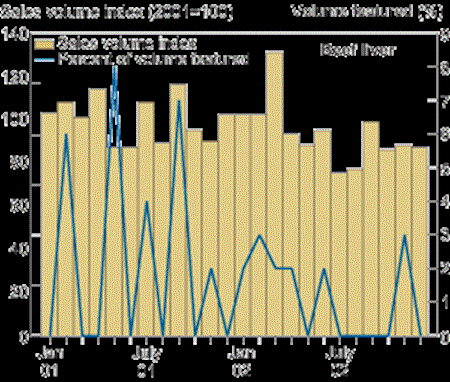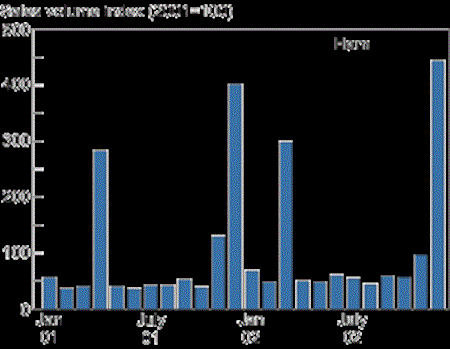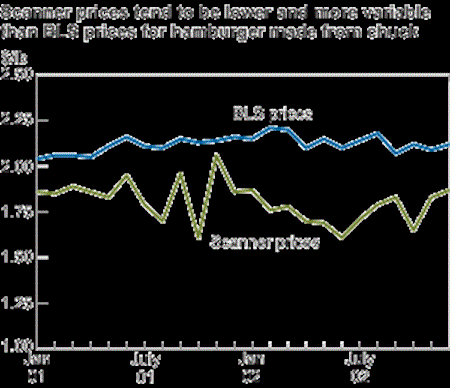Data Feature
Retail Meat Scanner Data
ERS has compiled supermarket scanner data of meat prices into a unique searchable database that contains monthly average retail price data for selected cuts of beef, pork, chicken, turkey, lamb, and veal. In addition to prices of various cuts of meat, the database includes information on the volume sold and the volume of 'featured' products sold under retailers' weekly advertised specials and frequent shopper discounts. These data are collected at the point of sale by supermarkets using electronic scanners in checkout lines. The data set reflects information from stores representing 20 percent of supermarket sales in the United States.
The database allows users to create custom tables in three different formats based on selected time periods (beginning in January 2001) and specific types and cuts of meat. The resulting tables report the average price of cuts of meat sold during the month, the volume of sales (indexed for 2001=100), and the percentage of volume sold under featuring (discounting). Other items on the web page include documentation of methodology, frequently asked questions, and descriptions of planned research.
Sales respond to discounting and season
Meat prices vary according to type of cut, season, and relative price of competing meats. Examining the impact of discounting and seasonality on the volumes sold of different cuts will help us understand the demand for meat and thus the forces shaping the livestock market.
When stores feature, or discount, a particular meat product, its volume of sales rises. The sales volume for chicken leg quarters, for example, appears to be quite responsive to featuring.
Conversely, if featuring activity is low, as it is for beef liver, the volume changes very little.
Seasons and holidays affect meat purchases even when prices are not discounted. For example, ground beef and steaks are popular during the summertime, but ham is heavily purchased around Easter, Thanksgiving, and Christmas.
How Are the Data Compiled?
Only supermarkets with annual sales of $2 million or more and that voluntarily provide their information are included in the study. These data do not include sales from fast food shops or restaurants, butcher shops, warehouse clubs, convenience stores, institutions, mail order firms, or food distributors that choose not to provide their data for commercial use. Commercial sources combine the data from retailers to protect confidentiality. Scanner data are grouped according to standardized categories. Then, after adjusting for feature discounts, prices are weighted according to volume to calculate the average price for a category (for example, round roast, USDA Choice boneless) for that month.
Scanner data for meat are particularly difficult to compile. Aggregation is complex because meat is sold in randomly sized packages and, unlike most other packaged foods, does not have uniform product codes (UPC) for each cut. In addition, stores can provide a name and code for a meat cut that is unique to that store, that geographic area, or that franchise. Because of the difficulties in assigning an average price to a given standardized cut, no one has used scanner data before for analysis of meat prices.
How Do Scanner Data Differ From BLS Price Data?
The Bureau of Labor Statistics (BLS) estimates the Consumer Price Index using retail food price data gathered by data collectors who visit a wide variety of stores. The new scanner data supplement BLS data by including more cuts of meat (for example, veal and lamb), data on volume of meat sold, and the effects of featuring (discounting).
The datasets differ in many other ways, as well. BLS data are based on a large sample and include stores that may not discount meat prices. BLS measures prices as snapshots in time every month. Scanner data, on the other hand, continuously capture purchase prices throughout the month. In addition, the BLS data may not capture the extent of supermarket featuring, which is assumed to be widespread. ERS data for many meat cuts show lower prices than BLS data by better capturing volume-weighted featuring and price variability.
Product Liability and Microbial Foodborne Illness, by Jean C. Buzby, Paul Frenzen, and Barbara Rasco, USDA, Economic Research Service, April 2001
Managing for Safer Food: The Economics of Sanitation and Process Controls in Meat and Poultry Plants, by Michael Ollinger and Valerie Mueller, USDA, Economic Research Service, April 2003
Calculating the Cost of Foodborne Illness: A New Tool to Value Food Safety Risks, by Elise Golan, USDA, Economic Research Service, April 2003
Retail Scanner Prices for Meat, USDA, Economic Research Service, November 2009





